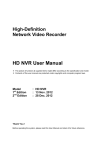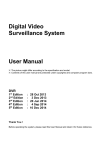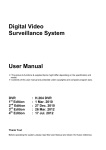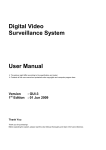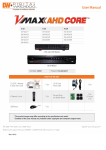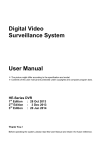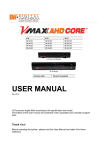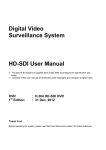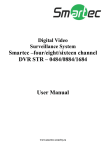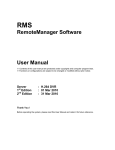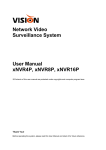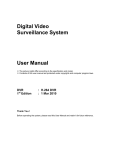Download Network Video Surveillance System User Manual
Transcript
Network Video Surveillance System User Manual ※ The picture might differ according to the specification and model. ※ Contents of this user manual are protected under copyrights and computer program laws. NVR 1st Edition : 15 Jan 2015 Thank You ! Before operating the system, please read this User Manual and retain it for future reference. WARNING TO REDUCE FIRE OR SHOCK HAZARD, DO NOT EXPOSE THE UNIT TO RAIN OR MOISTURE. The installation should be made by a qualified service person and conformed to all local codes. Cautions Read Before System Operation Follow these details to prevent material damage or personal injury. Signs of Caution and Warning Warning: This sign indicates that the user could die or be seriously wounded if not used or installed properly. Caution: This sign indicates that the user could be wounded or could expect property damage if not used or installed properly. Warning: Do not expose the product to fog, rain or too much humid to decrease danger from electric shock or fire. General Warning Warning 1. Use the power cord, which is supplied or recommended by the supplier, or it may cause fire. 2. Do not disassemble or reassemble the product. It may cause malfunction or fire. 3. Enquire to your vendor for repair. It may cause electric shock or fire if the repair is not done properly. 4. Do not touch the product with wet hands. It may cause malfunction or electric shock. 5. Product installation must be ensured to a professional for product installation, or it may cause malfunction, electric shock or fire. 6. Ground applies to video products equipped with a 3-wire grounding type plug having a third (grounding) pin. This plug only fits into a grounding-type power outlet. If grounding is not done, it may cause malfunction or electric shock. 7. Ground connection must not touch gas pipe, water pipe or telephone line. If grounding is not done properly, it may cause electric shock. 8. Prevent metallic foreign substance from going inside the product. It may cause malfunction or electric shock. 9. Do not spray insecticide or flammable spray while driving. It may cause fire. 10. Place the system in a open place where air ventilation is guaranteed, or it may cause over-heating and seriously damage the system to be fired. 11. Prevent water from instilling inside electrical parts. Clean with a dry towel or malfunction or electric shock could result. Caution 1. Use the power cord, which is supplied or recommended by the supplier. The internal fan rotates at high speed and may cause an accident. 2. Do not drop, give strong vibration, or shock to the product. It may cause malfunction. 3. The air inhaler of the front panel and air outlet of the back panel must not be blocked during installation. The internal temperature of the product would be greater than allowable and could cause malfunction or fire. 4. Do not touch the product or the power cord when there is thunder. It may cause electric shock. 5. Do not install the product near or on top of heating source. The internal temperature of the product would be greater than allowable and could cause malfunction or fire. 6. Do not install the product on inclined or unstable location or where vibration could be committed. It may cause malfunction. Cautions about the Power Warning 1. Must use the outlet of the grounding to connect the power cord, or it may cause fire. 2. Do not connect on the middle of power cord or use extension cord. It may generate heat or cause fire. 3. Do not touch the power cord with wet hands. It may cause electric shock. 4. Keep power cord dry and protect from humidity. It may generate heat or cause fire. The power cord is not waterproof. 5. Hold the body of the plug while removing the power plug. Do not pull the power cord. Damage to the power cord may generate heat or cause fire. 6. Check the power plug regularly. Humidity and moderation in smoking may cause fire. 7. Remove power cord from outlet when product is not used for a long time. It may cause short-circuit or electric shock. Caution 1. Do not turn off the power by removal of the power plug. To turn off the power, click the power button from the front panel. When the system stops abnormally, the power button might not work. Click power button for 5 full seconds to turn power off. 2. Do not cut off the power artificially, or give shock or vibration to unit while the hard disk is activating. It may cause hard disk failure or loss of data. Remarks ※ Pictures and buttons are subject to be changed or modified up to different models. ※ Function or configuration is subject to be changed or modified without prior notice for improvement of the product. 1 Contents 1. GETTING STARTED ............................................................................................................ 2 1.1 1.2 1.3 1.4 2. CHECKING SUPPLIED ITEMS ..................................................................................................... SYSTEM STARTUP ................................................................................................................. BUTTON EXPLANATION ........................................................................................................... SYSTEM SHUTDOWN.............................................................................................................. STARTUP WIZARD ............................................................................................................. 7 2.1 2.2 2.3 2.4 2.5 2.6 3. LANGUAGE ......................................................................................................................... 7 DATE/TIME ........................................................................................................................ 8 HDD FORMAT ................................................................................................................... 9 NETWORK ......................................................................................................................... 10 CAMERA ......................................................................................................................... 11 FINISH ............................................................................................................................ 12 OPERATION ..................................................................................................................... 13 3.1 3.2 3.3 3.4 3.5 3.6 3.7 3.8 3.9 3.10 4. 4.1 4.2 4.3 4.4 4.5 4.6 5. 5.1 5.2 5.3 5.4 6. 2 2 3 7 USER LOG-IN..................................................................................................................... 13 CAMERA REGISTRATION ........................................................................................................ 13 CAMERA DELETION .............................................................................................................. 16 CAMERA SETUP .................................................................................................................. 16 LIVE DISPLAY MODE ............................................................................................................ 18 PTZ OPERATION ................................................................................................................. 21 PLAYBACK RECORDED IMAGES ................................................................................................. 23 QUICK BACKUP DURING PLAYBACK ............................................................................................ 23 SEARCH RECORDED IMAGE ..................................................................................................... 24 DST SETTING AND IMAGE PLAYBACK ......................................................................................... 27 SETTING .......................................................................................................................... 29 SYSTEM ........................................................................................................................... 30 DEVICE .......................................................................................................................... 38 EVENT ............................................................................................................................. 43 RECORD ......................................................................................................................... 46 NETWORK....................................................................................................................... 49 BACKUP ......................................................................................................................... 57 WEB SURVEILLANCE THROUGH M/S IE ........................................................................... 60 WEB LOGIN ....................................................................................................................... 60 WEB MONITORING............................................................................................................... 61 WEB PLAYBACK .................................................................................................................. 61 SETUP ............................................................................................................................. 62 Q & A............................................................................................................................... 64 2 1. Getting Started 1.1 Checking Supplied Items Make sure that you have following items supplied with your NVR. If any of these items is missing or damaged, notify your vendor immediately. Keep the packing utilities for moving or storage purposes afterwards. Items Photo User Manual and Remote Software Quantity 1 Set (*) Quick Manual and CD 12V D/C Adaptor (48V D/C for PoE Model) & Power Cable 1 Set or IR Remote Controller 1 Set (*) Type of controller may differ depending on the NVR model and can be replaced by USB Mouse. Terminal Block and Rubber Mount 1 Pair (2 Pieces) 1 Set (*) Packed goods may differ depending on the NVR model 1.2 System Startup After connecting all peripheral devices, connect power cord to the NVR for system startup. Input USER and PASSWORD for login after turning on the system. The factory default of user and password are “ADMIN” and “1234” respectively. Admin user is to fully control the entire NVR system. If NVR is set as AUTO LOGIN, login process is not necessary. 3 Caution Note It may take a few minutes to startup the system after turning on the power, in case the user sets the network configuration as DHCP mode but under the situation that there is no DHCP server in the network or the network is not connected. 1) Do not forget the administrator’s password that was set for the first time. In case the password is forgot, contact your local dealer for help. 2) Refer to the “Section 4.1.2 User” for AUTO LOGIN and AUTO LOGOFF. 1.3 Button Explanation 1.3.1. Front Panel ** The picture might differ according to the model. ① Power : System ON/OFF ② LED Indicator : Indicates system status.(Power, Record and Network status) ③ USB Port : For backup, upgrade and so on. 4 1.3.2. IR Remote Controller 11 ○ 12 ○ 13 ○ 14 ○ 15 ○ 16 ○ 17 ○ 18 ○ ① ② ③ ④ ⑤ ⑥ ⑦ ⑧ ⑨ ⑩ ⑪ ⑫ ⑬ ⑭ ⑮ 16 ○ Power : System ON/OFF NVR ID Selection Numeric Button : Channel selection or Password input PTZ Button Preset Button : Select Preset on PTZ mode Focus Button : Focus IN/OUT on PTZ mode ZOOM Button : Zoom IN/OUT on PTZ mode Preset Tour : Tour ON/OFF on PTZ mode Direction Button Enter Button Menu Button Return Button Playback Button on Search mode Search Button Emergency Recording Button Auto-Sequence Button on Live mode 17 Screen Mode Button ○ 18 Backup Button ○ Note User can control multiple NVRs with one IR Remote Controller. In order to control multiple NVRs, each NVR has different Remote ID. (The initial ID is set as “0”.) Note How to setup the ID # in IR Remote Controller 1) Keep pressing ID selection button () for about 5 seconds. 2) Set the ID number by pressing numeric button on IR Remote Controller. ID number is available from 000 up to 255. 3) You have to press numeric button as three-digit number format. For example, press “000” for 0, “023” for 23, “234” for 234. User must setup REMOTE ID to match with the ID setting of IR remote controller, if user wants to use it to control NVR. 1.3.3. Tool Bar on Live Mode User can move the mouse pointer to the bottom of the monitor in live mode. Then menu bar will be instantly appeared as below picture. 5 Menu Button Menu screen will pop up. User can make the overall setting for NVR. (Please refer to the “4. Setting” for details.) Startup Wizard Button Shows Startup Wizard screen. (Please refer to the “2. Startup Wizard” for details.) Screen Display Mode Button User can change screen display mode. It changes to 1, 4, 9, 16ch mode in turn. PTZ Button In order to control PTZ for the channel that is PTZ camera is applied, click this button after selecting full screen mode for the channel. In PTZ mode, user can move pan/tilt and zooming-in/out by moving the mouse pointer, called virtual joystick. (Please refer to the “3.6 PTZ Operation” for details.) Easy Search Button Easy Search screen will pop up. (Please refer to the “3.2.2.2 Easy Search” for details.) Backup Button Can backup the recorded image to external device with this button. (Please refer to the “4.6 Backup” for details.) Playback Button It makes NVR playback the latest video clip, automatically. (Please refer to the “3.7 Playback Recorded Image” for details.) Search Button Search screen with various search modes are shown. User can search the recorded image, accordingly. (Please refer to the “3.9 Search Recorded Image” for details.) Exit Button User can exit with three different options, such as Log Off, Reboot and Shutdown. Pin Button It indicates that user can fix this menu bar, or disable fixing the menu bar by moving away the mouse cursor. If user fixes the menu bar, then this menu will not disappear even though user moves the mouse cursor away from that position. If user does not fix the menu bar, then the menu will be shown when user move the mouse cursor to the bottom area only. 6 1.3.4. Tool Bar on Playback Mode On Playback mode, the following menu is shown on the screen. Channel It indicates the currently selected channel number. Intelligent Search Bar It shows the recording status for the selected channel from 00:00 to 24:00. User can check whether there is recorded data or not and the recording mode, at a glance. White-vertical line indicates the time which is currently playback. User can move the white-vertical line to the time that user wants to search. (Please refer to “0 Schedule” for details on colors.) Previous/Next Date Search User can move to the previous date or the next date to search. Playback Control Button : Playback speed control. (x32 / x16 / x8 / x4 / x2). : Move backward by one frame : Stop button : Play button : Move forward by one frame : Playback speed control. (x2 / x4 / x8 / x16 / x32) : Shows current playback speed Screen Display Mode Button User can change screen display mode. It changes to 1, 4, 9, 16ch mode in turn. Backup Button User can backup the recorded images to the external devices. (Please refer to “4.6 Backup” for the details.) Playback Button It displays the latest recorded images. (Please refer to “3.7 Playback Recorded Images” for the details.) Exit Button Close playback mode and move to live mode. 7 Pin Button It indicates that user can fix this menu bar, or disable fixing the menu bar by moving away the mouse cursor. If user fixes the menu bar, then this menu will not disappear even though user moves the mouse cursor away from that position. If user does not fix the menu bar, then the menu will be shown when user move the mouse cursor to the bottom area only. 1.4 System Shutdown To turn off the power, Click exit button [ ] the tool bar and then click [SHUTDOWN] in the pop-up screen as below. Do not pull off the power by pulling the power plug. Input the password and click [OK] to shut down the system. And then, click [YES] to confirm shutdown in the pop-up screen as below. Note User can input password by virtual keyboard, IR remote-control or front numeric buttons (if available). 2. Startup Wizard At the first startup, Startup Wizard screen will pop up, automatically. User can make primary setting by simply following the steps in the Startup Wizard. User can open the Startup Wizard screen at any time by clicking Startup Wizard [ the tool bar ] button in 2.1 Language User can select the language according to the country or user’s preference. NVR supports various languages. If you cannot find your preferred language, please contact your dealer in your area accordingly. 8 Note If “DISPLAY ON SYSTEM STARTUP” is selected, Startup Wizard will pop up every time the system is started. 2.2 Date/Time User can make various settings such as time zone selection, DST (Daylight Saving Time) and time sync mode TIME SYNC MODE There are three types of time sync mode. § Server Mode The operating NVR is set as a Time Sync Server, which can synchronize the time clock of another NVR(s) connected over the same network environment. § Client Mode The operating NVR is set as one of the client NVR(s). Input the IP No of designated NVR or Remote Software P/C (CMS) as a Time Sync Server in “SYNC SERVER”, then NVR time clock is synchronized with Time Sync Server by interval time set in “TIME SYNC CYCLE”. § NTP Mode NTP server is one of standard time servers available on Internet and it is recommended to use “pool.ntp.org”. If you want to activate this mode, you have to correctly set the TIME ZONE of your local area and then click button [SYNC NOW]. 9 2.3 HDD FORMAT HDD FULL () User can select “Overwrite” or “Stop recording” when HDD becomes full. § Overwrite : NVR deletes the oldest data and record new data. § Stop recording : NVR stops recording. HDD CHECK () Click [CHECK] button ( ) of each HDD to open the window of NVR HEALTH CHECK. User can see full information of each HDD such as model name, serial no, capacity, bad sector ratio, life time (used time) and temperature. HDD FORMAT () When the new HDD is installed or there seems to be a problem on the HDD, user needs to format the HDD. If system resources are occupied such as network connection during format process, format may be failed. In this case, it is recommended to reboot the system to release system resources and then try to format again. User can select HDD to format by ticking the check box. Note 1) It may take a few minutes to format HDD. If it takes a long time, please check the status of HDD. 2) When the format is done, all data in the HDD will be deleted. 3) The system always reserves some space in each built-in HDD to effectively utilize archiving memory. 10 2.4 Network NVR can be connected to network or internet through either fixed IP or dynamic IP by proper setting of NVR and router. NETWORK TYPE Select either STATIC IP or DHCP for dynamic IP. If DHCP is selected, click [IP DETECT] button to receive the updated IP address information, then you can see the completion rate on “Progress Bar” IP ADDRESS In case of STATIC IP, user can set IP address for the NVR with In case of DHCP, it shows IP address which is set by DHCP. button. SUBNET MASK Subnet Mask address classifies the subnet that the system belongs to. For more information, please consult your network administrator or your internet provider. GATEWAY This is the IP address of the network router or gateway server. It is required when the user wants to connect through external router. For more information, please consult your network administrator or your internet provider DNS SERVER Enter the IP address of the Domain Name Server. You should input the DNS Server information in order to use DDNS, E-mail notify and NTP Server. If it is hard to know the correct information, user can input “8.8.8.8”. For more information, please consult your network administrator or your internet provider. TCP/IP PORT Input the port number to use when connecting locally or remotely. It is for use with Remote Software P/C (CMS) and Mobile Device (MMS). WEB PORT Input the port number to use when connecting from the Web Browser. AUTO IP The system IP which is assigned through Auto-IP, automatically. BANDWIDTH LIMIT Depending on the setting made by user, the system can control the data volume transmitted over network ranging from 25 kbps up to 1Gbps. This function is effective especially under narrow bandwidth network condition or when user wants to limit “network bandwidth occupied by video transmission” to a certain level. 11 UPnP (Universal Plug and Play) UPnP supports “auto port forward function (NAT TRAVERSAL)” even if the user does not set port forward in the router. It may not be supported in some routers and some network conditions. Input necessary information based on your network environment. NETWORK TYPE : Select STATIC IP (in case of fixed IP) IP ADDRESS : Assign a local IP # to NVR (ex, 192.168.0.164) SUBNET MASK : Input subnet mask of your LAN (ex, 255.255.255.0) GATEWAY : Input gateway of your LAN (ex, 192.168.0.1) DNS SERVER : Input IP # of your DNS server You must input this IP # for internet connection. Please contact your ISP to get this IP#. You can input “8.8.8.8” in case you do not know this IP#. § TCP/IP PORT : Default is 9010. If your ISP blocks the port # 9010, you need to input another valid port number. (ex, 9020) § WEB PORT : Default is 80 If your ISP blocks the port # 80, you need to input another valid web port number. (ex, 8080) § BANDWIDTH LIMIT : Default is 100 Mbps. Select bandwidth limit you want to set in consideration of network condition. § § § § § Note Note The maximum number of simultaneous connection is 15 users. For the other network settings, such as DDNS, Notification, Mobile Push & P2P Cloud, please refer to the “4.5 Network”. 2.5 CAMERA User can check the registered cameras and delete them or register new camera. Please refer to “3.2 Camera Registration” for the details.) Auto Search [Once the user clicks [AUTO] button, NVR searches all cameras under the same network (Router) and register them in order, automatically. It is not recommendable in case that there are multiple NVRs in the same site. It is because the same camera can be connected to the multiple NVRs. In this case, user is recommended to use 12 another method. Easy Search ① Click [EASY SEARCH] button to search camera. ② Select camera in the list and drag and drop it to the channel which user want to put. (While it is moving, mouse pointer is change to.) ③ Click [APPLY] button to finish the process. Search NVR founds IP cameras which are in the same network. User can select cameras and register/set them. Channel Group Max. 8ch can be displayed. Click another group button to see another channels. 2.6 Finish When the setting is finished, click “FINISH” button to close Startup Wizard. 13 3. Operation 3.1 User Log-in Check the power connection. Input USER and PASSWORD for login after turning on the system. The factory default of user and password are “ADMIN” and “1234” respectively. Admin user is to fully control the entire NVR system. Note 1) LOGIN window will be permanently displayed in monitor as above picture until user logs in with the right ID and password. 2) If NVR is set as AUTO LOGIN, login process is not necessary. (Please refer to the “4.1.2 User” for details ) 3.2 Camera Registration NVR can connect to the multiple IP cameras through network. In case of PoE channel, it doesn’t require power connection separately. Note Minimization of repetitive job for registration User doesn’t require ID & Password once the same camera is already registered. But, some models requires ID & Password, if it has different ID & Password by user’s setup. 3.2.1. PoE Camera Connection PoE camera is automatically connected in a few minutes when the camera is plugged to the PoE port and the channel title of the screen is shown as green color. PoE camera’s network setting must be set as ‘DHCP’ before connecting to NVR. But, some cameras which support ‘Auto IP(or Zero Configuration)’ are not required DHCP setting. These camera’s IP setting is automatically controlled by NVR. Note If PoE camera is connected to the PoE channel while another camera is being assigned to that channel, the already assigned camera moves to another channel and the PoE camera is newly assigned to that channel. Note Zero-Configuration It is the Link-Local IP address assignment method through Auto-IP and it is for assigning IP, automatically, when the DHCP is not existed. The device that adopts this technology selects 169.254.xxx.xxx, in general, and assign the IP address after checking the availability of the selected IP address 14 3.2.2. Camera Connection through Network 2 3 1, 4 5 Go to “EXPERT MODE” in Camera Menu(Menu > Record > Camera Register). NVR supports various registration methods. 3.2.2.1. Search ① Click [SEARCH] button to search all cameras which are under the same network(Router). Some cameras which support ‘Auto IP(or Zero Configuration)’ can be searched even it has the different IP address range from the NVR. ② Search camera to register and click [GET PROFILE] to read profile of the camera. ③ When [GET PROFILE] button is clicked, NV assigns channel number of empty channel, automatically. If necessary, user can select specific channel number. ④ [DETAIL INFO] button allows user to check the camera information in detail. ⑤ [SETUP] button allows user to control camera setting.(Resolution/Frame/Bitrate/Image Quality) ⑥ Click [SETUP] button to register the selected camera to the NVR. If necessary ID and Password should be input. Note Information User can check the detail of the camera such as model name, IP address, Port number, Mac address and so on. 3.2.2.2. Easy Search ① Click [EASY SEARCH] button to search camera. 15 ② Select camera in the list and drag and drop it to the channel which user wants to put. (While it is moving, mouse pointer is changed to ③ Click [APPLY] button to finish the process. .) 3.2.2.3. Auto Search Once the user clicks [AUTO] button, NVR searches all cameras under the same network (Router) and register them in order, automatically. It is not recommendable in case that there are multiple NVRs in the same site. It is because the same camera can be connected to the multiple NVRs. In this case, user is recommended to use the following method (“3.2.2.4 Multi Select”). 3.2.2.4. Multi Select ① Click [SEARCH] button to search cameras. ② After searching cameras, user can find camera list. Then, user can change line up as per each property(Protocol, IP Address, Hardware & Name) by clicking each property tabs. The selected property is shown as yellow/green. ③ Choose [MULTI SELECT] and select multiple cameras which user wants to register to the NVR. Selected camera is changed into green color. ④ When [APPLY] button is clicked, camera is registered one by one from the top. The registered camera is shown as unselected. Note During the registration process of Multi Select, if there is a camera which has a different IP range or requires ID & Password, the process is paused and NVR requests input the required information. In this case, user should input the required information for the camera which is on the top out of selected cameras. If there is a camera which has d different IP range, NVR asks to change IP. Then, user can input IP manually or set DHCP or make IP set automatically. 3.2.2.5. Manual Add If user wants to connect to an IP camera which is in the different network, manual add can be 16 used. ① Click [MANUALLY ADD] button to open the camera property window. ② ③ Select channel number to register. Select protocol(ONVIF, RTSP, FOCUS, VHT) of the camera. Registration is available with one of the following. – IP Address, RTSP URL or ONVIF URL ④ Input necessary information with button and click [GET PROFILE] button to get profile information. If the profile is shown, the registration is available. Click [APPLY] button to register camera. ⑤ 3.3 Camera Deletion Go Camera Menu(Menu > Record > Camera). ① Non-PoE Camera ② Delete( ) button is always activated. Click of the camera to delete. PoE Camera PoE camera cannot be deleted while it is being connected. In order to delete PoE camera, unplug PoE camera from the NVR and click it is activated. 3.4 Camera Setup User can change setup of the registered camera. button when 17 3.4.1. Setup for Each Camera Go to Camera menu(Menu > Record > Camera) and click [SETUP] button to get into the camera setup뉴window. Or, open pop-up menu by clicking right mouse button in the live mode and select [CAMERA SETUP]. ① Click [GET PROFILE] button and get current camera status. ② Click [SETUP] button to change resolution, frame rate, image quality and so on. RESOLUTION : Recording image size. FPS : Frame rate to transmit. BITRATE : The maximum bitrate that camera use for image transmission. QUALITY : Image quality for recording. It affects to the recording file size. GOP : Group of pictures. The interval of I-Frame. H.264 I-REFERENCE : Recording frame interval out of transmitted frames. (ex. x2 means records one frame out of two frames) If it is not used, NVR records all transmitted frames. Note I-REFERENCE Differently from DVR, NVR records all data which come from IP camera. That is, frame rate of live display should be the same as that of recording. However, if user uses IP camera that supports I-REFERENCE, user can make it different. That is, user can monitor live display with full frame and record it with lower frame. - If user sets ‘H.264 I-Reference’ as “4X”, it means that 1 frame out of 4 frames is recorded. - If user sets ‘H.264 I-Reference’ as “2X”, it means that 1 frame out of 2 frames is recorded. - It is also related to the setting of frame rate and GOP(Group of Picture). Ex 1) FPS: 30, GOP: 30, I-Reference: 4X à recording frame will be about 7.5fps Ex 2) FPS: 15, GOP: 30, I-Reference: 4X à recording frame will be about 3.7fps - It is useful for extending recording period without dropping of live monitoring frame rate. 3.4.2. Quick Setup User can setup multiple cameras with the same model at once. 18 ① ② ③ ④ ⑤ ⑥ Select model to setup. Click [GET PROFILE] button and get information. Click [Get INFO] button and check current setup value. Change setup and click [SAVE] button. Check how many cameras’ setup will be changed. “CAMERAS ARE SUCCESSFULLY APPLIED” message is shown when the process is completed. 3.4.3. Change channel Without any further registration process, user can change channel by drag & drop. Select the camera with mouse and drag it to the channel to move and drop. (During drag, mouse pointer is changed to ) In case of a PoE camera, channel title will be shown like below picture and user can check PoE port number of that camera. Channel No. PoE Port No. Channel Title In Live mode, user can check the status of PoE cameras by selecting [PoE STATUS] menu in the pop up menu window. 3.5 Live Display Mode 3.5.1. Channel Selection Real-time live image can be seen by easy button operation after power-on. The images can be seen on real-time by 1, 4, 9and 16 screen. Whenever the up/down arrow button on the front panel or IR remote controller is pressed and whenever the screen display mode button ( ) on the tool bar is clicked, the screen will be sequentially changed. [1 Ch] [4 Ch] 19 [9 Ch] [16 Ch] To select channel by mouse, click of the left mouse button. To return to previous screen mode after selecting certain full channel, click of the left mouse button. “VIDEO LOSS” is shown on the display screen when no camera is connected or camera is disconnected on a certain channel. When camera is disconnected, warning sound shall be generated depending on the system setting. And, admin user can set different level of authorization for each user. If a certain user is not authorized to view a certain live and playback channel, then no image is shown on the display screen as below. 3.5.2. Icons In real time live mode, icons or messages will be indicated on the screen to notify the system mode or status. Below are the icon categories, which are indicated on the monitor. Icon to be shown at right-upper corner on each channel screen Icon to be shown at right-bottom corner on full screen Continuous Recording No HDD. Motion Detection Recording Using Emergency Recording Sensor Activating Recording Using PTZ Continuous + Motion Alarm Recording Continuous + Sensor Activating Recording Motion Detection + Sensor Activating Recording Warning for temperature Emergency Recording exceeding Showing sequence mode Showing digital zoom mode 20 Sensor Activated Motion Detected Audio Channel PTZ Camera POS Note If you cannot find any recording icon in the right up corner of the live screen mode, then it means that the system does not record any image. In this case, you need to check recording schedule or camera of the main setup menu. 3.5.3. Pop-up Menu User can click the right button of the mouse to pop up sub-menu as below. If user want to control a specific channel, put the mouse cursor on that channel and then click the right button. DISPLAY User can change screen display mode. SEQUENCE When “SEQUENCE” is selected, icon is shown on the right-bottom corner of the screen and display screen will be sequentially changed. ZOOM(Digital-ZOOM) w It is activated in 1 screen display mode, only. When “ZOOM” is selected, icon is shown on the right-button corner of the screen and digital zoom control is available. (It is different from the zoom by PTZ.) w User can zoom-in by mouse dragging on the desired area and also user can control zoom-in & zoom-out by mouse wheel control. Once the image is zoomed-in, user can move that area by mouse dragging or exit by mouse click. w To exit from the zoom mode, click the right button of the mouse and select “ZOOM EXIT’ in the menu. ADJUST It goes to menu to adjust camera image.(Please refer to “4.2.1 Camera”). User can adjust image such as brightness, contrast, color and so on. PTZ It goes to PTZ mode. (Please refer to “3.6 PTZ Control” for detail.) CAMERA SETUP It goes to the menu to setup camera.(Please refer “3.4.1 Setup for each camera”) User can setup resolution, frame and so on. 21 FREEZE It makes live image paused. But system clock (date/time information) continues running. Select “FREEZE” again to resume the live view. ADD BOOK MARK User can add bookmark with description on the currently displayed image. When the menu, which is shown on the left, is opened, user can put description with button. SEARCH User can search recorded image with various ways, such as, Calendar, Date/Time, First Data, Last Data, System Log, Event Log, POS & Bookmark. (Please refer to “3.6. Search Recorded Image” for details.) RECORDING INFO User can check the recording status of the NVR, such as Recording Period, Daily Recording Size(Average), Recording Days and Remaining Recording Days. POE STATUS User can check the status of all PoE cameras which are connected to the NVR. And reset all PoE camera. MENU User can open main menu setup screen. 3.6 PTZ Operation In order to operate PTZ, the channel which is connected by PTZ should be in full screen mode. User can get into PTZ mode by right-clicking the mouse button and selecting “PTZ” in the pop-up menu as below, or select PTZ icon in the menu bar. When it is in the PTZ mode, is shown on the right-button corner of the screen. PTZ Control In PTZ mode, user can control PTZ operation with USB mouse. While pressing the left button of mouse, user can drag the mouse cursor to up/down or left/rightward to move pan/tilt position of the camera. If user moves the mouse cursor to further extend from the center position of the main screen, icon 22 the PTZ camera moves at faster speed. On the contrary, if the mouse cursor is getting closer to the center, the PTZ camera moves slower. Note Full PTZ functions are available by using USB mouse, IR remote control, or keyboard controller. ZOOM/FOCUS User can also move zoom-in/out by rolling the wheel of mouse to up or downward. If user changes the mode into “Focus” in the pop-up menu, focus can be controlled by rolling the wheel of mouse. PRESET When the preset menu pops-up, select the preset number and click “Enter” button to move to the corresponding preset position. Maximum Preset number is 255 (It can be restricted by the number that PTZ camera supports). TOUR User can on/off the TOUR function. When the ‘TOUR’ is on, camera moves to preset positions in order. It keep moving until user turns it off. GUARD TOUR User can automatically switch PTZ camera position according to the sequence of preset setting by using GUARD TOUR function, though the connected PTZ camera does not support it. “GUARD TOUR” on the pop-up menu can be enabled after changing to full screen for the channel that the PTZ camera is connected to. Please make sure that PTZ camera setting is correct, otherwise, “GUARD TOUR” is shown as disabled. (Please refer to “4.2.3 PTZ” for setting.) Caution User can set interval for each preset position. Depends on PTZ camera, some preset positions might be skipped in the case that the PTZ camera cannot mechanically move or control focus within the interval time set by NVR. In this case, it is recommended to make setting of interval time a little longer. GOTO HOME Camera moves to the original position that is memorized in the PTZ device. It depends on PTZ model. SETUP It goes to PTZ setup menu(Please refer to “4.2.3. PTZ”). PTZ EXIT Close PTZ mode screen and move to live mode. 23 3.7 Playback Recorded Images To playback recorded image, press Play button from the Front Panel, IR Remote Controller or playback icon ( ) in the menu bar. When it goes to playback mode, it automatically playback the latest recording image. It is easy to use USB mouse or the Front Panel’s Jog/Shuttle to playback recording files. Turn the Jog and the recorded files can be seen backwards or forwards. Turn the Shuttle and the playback speed can be controlled 2, 4, 8, 16, 32 times while playback backwards or forwards. Note Jog/Shuttle in the front panel will not be available depending on the NVR model. Date/Time() It shows date & time of the image that is being displayed, currently. Tool Bar() It contains various functions such as playback control, recorded data check, screen mode and so on. (Please refer to “1.3.4. Tool Bar on Playback Mode” for detail.) Pop-up Menu() w Display : Change display mode (1, 4, 9, 16 screen mode) w Backup : Backup recorded data w Search : Search recorded data by various conditions w (Please refer to “3.8 Search Recorded Image” for detail.) w Add Bookmark : Add bookmark to the current image and make it easier to be searched w Live Mode : Go to Live mode Exit Playback Mode() In order to exit from the playback mode, click Exit icon in the menu bar. 3.8 Quick Backup during Playback User can easily archive video while he/she watches video playback. In playback mode, user can press “ENTER" button in the front panel to set archive “start” time. After pressing this “ENTER” button, user will see “Quick backup starts” in right bottom of the playback monitor. Press “ENTER” button to set “start” and “end” time during video playback. Button type may be different depending on the NVR case 24 Once “Quick backup starts” message is shown(), user can keep playing back video until user wants to finish archiving, and then press the same “ENTER” button again to set backup “end” time. Then, backup menu window will be popped up and user can select the backup media like CD/DVD or USB thumb drive, and execute archiving. Note [HELP] button can help you understand how to setup several important settings. For example, if you need help about how to set Backup, click [HELP] button at the right bottom of the menu). 3.9 Search Recorded Image User can search recorded image with various conditions. Note There are several ways to get into the search menu. ① In Playback mode, Pop-up menu à Search menu. ② In Live mode, Tool bar à Search button ③ [SEARCH] button in front panel 25 3.9.1. Calendar Search The user can select date and time to search for a certain file within the recorded image. User can move the white-vertical line () to the time that user wants to search. The colors of the time bar are different by each recording mode. Please refer to “4.4.2” for details on colors. Time bars in color shows by 4channel group. To check another channel group, select group button on the bottom of the window (). “*” mark in date as above picture () means that there is a video data recorded. 3.9.2. Search Date/Time Enter the desired date and time to playback the recorded image. Use the arrow button or mouse to move to each day/month/year and time category for selecting second / minute / hour / month / year. 3.9.3. First Data Go to the first screen of the recorded image. This is the oldest image recorded. 3.9.4. Last Data Go to the last screen of the recorded image. This is the latest image recorded. 3.9.5. System Log The system log search is used to find particular system log information, quickly and easily. ① Select date to search. 26 ② ③ ④ ⑤ Select log type to search. User can search one by one or all at once. Click [SEARCH] button to show list with time and event. Click [EXPORT] button to copy the list to external device such as USB memory stick as “.txt” file. Once export is completed, user can find a date folder created in USB memory stick. There is “system.log” file stored in the date folder. 3.9.6. Event Log The Event log search is used to find particular event, quickly and easily. ① ② ③ ④ Select date to search. Select log type to search. User can search one by one or all at once. Click [SEARCH] button to show list with time and event. Click [EXPORT] button to copy the list to external device such as USB memory stick as “.txt” file. Note In case the Alarm does not activate even though the alarm input setting had been done, check the alarm connection port of the product’s rear panel. Note 20 numbers of log record will be shown on one page of the [System Log] and [Event Log] window. User can click the arrow button ( ) to search the log records on another page. 27 3.9.7. POS Input the search information (channel #, date, time & keyword) and then click [SEARCH] button to get the list. If no keyword is input, system will display all data during designated time period. Click [PLAY] button to display the searched video image and POS data as well. 3.9.8. BOOKMARK Bookmark data can be checked, modified and deleted. Select one of them in the list and click [PLAY] button to display the correspondent video image. 3.10 DST Setting and Image Playback During DST (Daylight Saving Time) period, NVR time clock has to be adjusted according to regional time zone. That is, NVR time clock will be shifted by one hour after DST setting while NVR will restore the time clock to normal after DST finishes. 28 3.10.1. DST Setting To make DST setting on the NVR, go to the menu of SYSTEM > INFORMATION and click “DATE/TIME ” to open date & time setting window as below. User can select “USE DST” to apply DST time change. 3.10.2. DST Image Playback There is an hour overlapped data when DST finishes. Such period of hour will be indicated in Blue color in Intelli-Search Bar on playback mode. When user click on such overlapped period, a message of “Data Selection” will pop up, then user can select whether to play DST data or Non-DST data. Click [OK] to play DST image [“DST” image is displayed] Click [CANCEL] to play Non-DST image. [“Non-DST” image is displayed] 29 4. Setting General setting structure consists of “System”, “Device”, “Event”, “Record”, “Network” and “Backup” as below. Main Classification Sub Classification INFORMATION USER SYSTEM DISPLAY HDD CONFIGURATION CAMERA AUDIO DEVICE PTZ POS KEYBOARD SENSOR EVENT MOTION ALARM EVENT ALARM CAMERA RECORD SCHEDULE QUICK SETUP NETWORK DDNS NETWORK NOTIFICATION MOBILE PUSH P2P CLOUD BACKUP BACKUP User can find the menu icon in the menu bar or menu button in the pop-up menu by right clicking the mouse button. User can move mouse cursor from “System” through “Backup” to instantly look around the sub-menus in the menu screen. 30 4.1 System 4.1.1. Information SITE NAME User can designate the site name by using virtual keyboard as below. SITE ID User must setup SITE ID to match with the ID setting of keyboard controller, if user wants to use it to control NVR. User also needs to select the correct model of keyboard controller and BUAD RATE setting in “MENU > DEVICE > KEYBOARD” menu (Please refer to “4.2.5 Keyboard” for detail). DATE/TIME User can make various settings such as time zone selection, DST (Daylight Saving Time) and time sync mode. There are three types of time sync mode. w Server Mode The Operation NVR is set as a Time Sync Server, which can synchronize the time clock of 31 another NVR(s) connected over the same network environment. w Client Mode The operating NVR is set as one of the client NVR(s). Input the IP address of designated NVR or Remote Software P/C (CMS) as a Time Sync Server in “SYNC SERVER”, then NVR time clock is synchronized with Time Sync Server by interval time set in “TIME SYNC CYCLE”. w NTP Mode NTP server is one of standard time servers available on Internet and it is recommended to use “pool.ntp.org”. If you want to activate this mode, you have to correctly set the TIME ZONE of your local area and then click SYNC NOW. And user can set “DST (Please refer to “3.7 DST Time Setting), ‘Time Zone’ and ‘Date/Time Format’. Note “HELP” button can help you understand how to setup several important settings. For example, if you need help about how to set Date/TIME, click “HELP” button at the right bottom of the menu. LANGUAGE User can select the language according to the country or user’s preference. NVR supports various languages. If you cannot find your preferred language, please contact your dealer in your area accordingly. REMOTE ID User must setup REMOTE ID to match with the ID setting of IR remote controller, if user wants to use it to control NVR. VERSION User can check version of system. User can easily upgrade the system firmware via DVD/CD/USB Memory Stick/FTP server. Caution Do not click CANCEL button during firmware upgrade. It may cause serious damage on the system !!! The setting value might be changed to that of factory default in case that there are a lot of changes between new firmware and existing firmware in functions, etc. Therefore, it is recommended to check the setting value and operating condition of the NVR after firmware upgrade. Procedure How to upgrade system firmware by using USB memory stick 1) Put USB thumb-drive which was formatted by FAT/FAT32 in any USB port of NVR that shall be compatible with USB 2.0 version 2) Once the system detects the thumb-drive, user can see a brand or model name in “DEVICE” after pressing [SCAN] button. 32 3) Select NVR name and version to be applied, and then click [OK] to confirm. (*) It is not allowed to use the partitioned USB memory. [Automatic firmware upgrade through “PUSH ALERT”] ① Select METHOD as “FTP” ② Default FTP information operated by manufacturer (Host address, username and password) is shown as below. User must have prior consultation with the manufacturer if he wants to operate his own FTP server. ③ Enter your convenient time at CHECK TIME and then click [SAVE] button. ④ The system will regularly check whether the latest version of firmware is available at FTP server and generates alert message if the latest version is found. ⑤ Click [OK] button to proceed automatic firmware upgrade. After completed, the system will reboot. VIDEO SIGNAL Check the right video signal (NTSC or PAL) according to the country. This setting should be matched with the [NTSC/PAL Selection Switch] located on the rear panel. Video images might be heavily shaking and blinking in probably black & white if NTSC/PAL is not properly set. IP ADDRESS It shows IP Address of the NVR. It can be set at ‘MENU>NETWORK>NETWORK’. MAC ADDRESS It is the unique identity number for each system. KEY PAD BEEP User can turn on or off the beeping sound of key pad. 4.1.2. USER The ADMIN user (default password is 1234) has got the full authority for system setting, and can change the system password or add/delete user list and assign different permission level to each user. Note Maximum number of users including administrator is 16. User Management Admin user can control authorization for each function. This authorization is applied the same when the user connect to the NVR from the remote software. 33 ① Add User To add new user, click [ADD] button to open the new window. In this window, admin user can set new user’s ID, description, password and select functions/menu access to allow to the new user. In Live & Playback, only the selected channels are allowed to monitor by the user. To change the setting, select user and click [Edit] button. And then do the same setting as above. ② Delete User Select user in the list and click [Delete] button. ③ Option w If user select Auto Logon “On Boot”, NVR doesn’t request ID and password when it turns on. w If “Auto Logoff” is set, and no operation is applied during the set time, NVR becomes log off status. Then, user has to login again to operate the NVR. Example : How to set a user with “Live Monitoring Only” 1) Add a new user name, description and password. 2) Disable all options in [FUNCTION] and [MENU ACCESS]. 3) In [LIVE & PLAYBACK], select channel(s) for live monitoring, and click [OK]. 4) Click [SAVE]. 5) To verify this limited function, log-off through Exit icon and login as the user set above. User can receive the live images. However, when user clicks payback button or select any other function, warning message of “No Permission for this function.” will pop up. 34 Setting Authorized Level at Remote Software (CMS) Level of authority for the user is linked up between NVR and Remote Software. If a user has been restricted for certain permissions in NVR operation such as “Live and Playback of each channel, Search, PTZ Control and Backup”, then those restrictions will also be applied for same user when operating Remote Software : How to set a User with “limited access of camera channels” Example : How to set a user with “limited access of camera channels” 1) Open Site Registration, and add new site. 2) Input User ID and Password (which has already been registered in NVR, with limited access of certain camera channels). 3) Connect the site at Monitoring Window, then the limited accessible camera channels will not be shown. Note User ID in Site Registration of Remote Software 1) The authority of a certain User ID at Site Registration is governed by the permission level set in NVR. 2) Such User ID should be pre-registered in NVR with designated permission level. If user has been registered in Remote Software only (not in NVR), then such user cannot be connected to the NVR via Remote Software. 4.1.3. DISPLAY User can set sequence dwell time, VGA resolution, OSD display, spot-out dwell time and spot-out channel & dwell time as below picture. 35 SEQUENCE Set dwell time for sequential channel display.. VGA RESOLUTION The system supports three kinds of video resolutions f o r H D M I a n d V G A : 800x600, 1024x768, 1280x1024 and 1920x1080. User needs to set the proper resolution in accordance with the monitor resolution. OSD Select OSD caption to be displayed. SCREEN SAVER User can make Screen Saver function work for VGA output and TV output. Interval for Screen Saver can be set in between 1 minute and 180minutes. 4.1.4. HDD HDD FULL () User can select “Overwrite” or “Stop recording” when HDD becomes full. § Overwrite : NVR deletes the oldest data and record new data. § Stop recording : NVR stops recording. HDD CHECK () Click [CHECK] button ( ) of each HDD to open the window 36 of NVR HEALTH CHECK. User can see full information of each HDD such as model name, serial no, capacity, bad sector ratio, life time (used time) and temperature. HDD FORMAT () When the new HDD is installed or there seems to be a problem on the HDD, user needs to format the HDD. If system resources are occupied such as network connection during format process, format may be failed. In this case, it is recommended to reboot the system to release system resources and then try to format again. User can select HDD to format by ticking the check box. Note 1) It may take a few minutes to format HDD. If it takes a long time, please check the status of HDD. 2) When the format is done, all data in the HDD will be deleted. 3) The system always reserves some space in each built-in HDD to effectively utilize archiving memory. Caution WARNING MESSAGE To achieve high-level system stability, warning message of high temperature will be popped up when temperature inside the system exceeds optimum range. This problem may be driven from mal-function of ventilation fans. In this case, user shall inspect if the cooling fan is properly working, or ambient temperature around the system is properly kept. 4.1.5. CONFIGUTATION FACTORY DEFAULT With authorized password, user can make the system back to factory default configuration. Once the factory default is done, all the configurations made by user will be deleted and the system setting will be originated by factory default. However, recorded video data are protected. EXPORT/IMPORT Copy and paste the system configurations in this menu. § Export : Copy the settings of this system to USB memory devices. § Import : Call up the settings of other system from CD/DVD/USB memory devices. 37 During import process, make sure that the F/W version of the sourced NVR has to be same as the one of target NVR which user wants to import settings to. 38 4.2 DEVICE 4.2.1. CAMERA User can set each camera’s title, motion area and color adjust. TITLE In order to distinguish the channel from the others, user can designate the channel name. The name is applied to both NVR and remote monitoring software. COVERT If a channel is set as COVERT, no other users except administrator can see the image in live & playback mode. It is applied to both NVR and remote monitoring software. PRIVACY MASK Admin user can block specific area not to shown in live and playback mode. Some cameras may not support this function. Click [SETUP] button to get into the setup mode. ADJUST Set channel image like brightness, contrast, color and so on. Click [SET] in the ‘ADJUST’ section to get into set screen. 39 User can change channel with the arrow button( [Apply All] makes all channels have the same value. Click [EXIT] to exit. ). 4.2.2. AUDIO User can select audio input and output during live display, and match the audio input to a designated channel. Number of audio channel may differ depending on NVR model. User can hear audio sound under both live display and playback mode depending on the system setting. Select “USE 2-WAY AUDIO” to make voice communication between NVR and remote side. 4.2.3. PTZ Full control of PTZ camera is available in this menu. For details, please refer to “3.3 PTZ Operation”. Check the below items for proper P/T/Z operation. Check if the protocol of the connected PTZ camera is correct. Check if the communication setting including baud rate of the connected PTZ camera is in accordance with the assigned value for that P/T/Z protocol. Check if the address of the connected PTZ camera is correct. Check if wiring to P/T/Z controllers is correct. Procedure How to setup PTZ camera with Pelco-D protocol (example) 1) Make sure of serial communication with the PTZ camera through RS-485 port. 2) Select “Pelco-D” in the protocol list, and set address. 3) Click “Save” button to confirm this configuration. 40 PROTOCOL Select the proper protocol of the connected PTZ camera. BAUD RATE Select the baud rate level from 2,400bps up to 57,600bps. ADDRESS Set the P/T/Z driver address of the connected camera. It should be the same as that of the PTZ. CONTROL(* The functions are depends on the PTZ model.) When the [SET] button is clicked, OSD menu of the PTZ camera will be shown on the monitor. User can set the PTZ such as speed, preset, tour, auto pan and so on. ① Direction buttons : move camera up/down & left/right. ② M (depends on PTZ model) : It shows PTZ camera’s OSD menu on the NVR monitor. While the menu is on the NVR monitor, user can set PTZ menu with direction button (○ 1). ③ ZOOM/FOCUS/IRIS : Control IN(+)/OUT(-) for each functions. ④ Speed : Change PTZ speed(0~100) and apply it by clicking [SET] button. ⑤ Preset w Set : Control PTZ position with direction button() and lens control button(). And put the number with button and finish it with [SET] button. (The system supports preset the number of preset from 1 to 255. But it can be restricted by the number that PTZ camera supports.) w Move : Put the number with button and click [Move] button to move the camera to the preset position of that preset number. ⑥ TOUR : Camera moves the preset position in order. It keeps moving until turning off. ⑦ AUTOPAN : Camera moves 360 ° in one direction. It keeps turning until turning off. ⑧ GUARDTOUR : User can select some presets to have PTZ camera move to those positions with the set order and interval. Camera keeps moving until turn off the function. w Set : Set the Interval(Sec) and select the preset position and add to Sequence by clicking button. It shows like “P1(5)” and means Preset No and Interval. w Delete : To delete preset position, select preset in Sequence and click button. ⑨ HOME : Camera moves to the original position that is memorized in the PTZ device. It depends on PTZ model. 41 4.2.4. POS POS equipment can be connected to NVR through RS-232 port or LAN. NO Port Number of Serial Mux. ex) NO1 = COM1, NO4 = COM4. CAM Camera to link to POS device TYPE Connection type between NVR and POS device PROTOCOL Communication protocol between NVR and POS device. SAVE Save the POS data or not SHOW Display the POS data or not SETUP () Go to the setup screen. - POS SETTINGS w NO : ID# of POS device w CAMERA : Select the camera to link with POS device w TYPE : Select COM (RS-232) or TCP/IP (LAN) w POS IP : Input IP of POS device when it is connected through network w PROTOCOL : Communication protocol between NVR and POS device ① TEXT-IN: Receive ASCII character ② SNVR-POS: Manufacturer’s own protocol v Please contact your POS dealer for details. w START CHARACTER : Input the assigned character to start display and save. If there is no input, the system will display and save all data without classification per transaction. w END CHARACTER: Input the assigned character to terminate display and save. It must have START CHARACTER to work correctly. w LINE BREAK: Set the line change character. (It should be 16 digits HEX Value.) ① [CRLF] / [CR] / [LF]: The character that is generally used in ASCII-type POS. (Please contact POS manufacturer for the detail.) 42 w SAVE ② [Custom]: It can be used except the above general character. Only number (0~9) and alphabet (A ~ F) can be used and even numbers should be input. ex) Hexadecimal: 0x0D 0x0A → 0D0A : Save POS data. - LIVE DISPLAY SETTINGS w DISPLAY LINE : Set the number of line to be displayed on the screen. w CLEAR TIME : Set the time period to be displayed on the screen. The data will be deleted if no more data is input after the setting time here. If it is set as “0”, the data will not be deleted (If there is Start Character and the character is input, current data will be deleted regardless of the Clear Time setting) w POSITION : Designate the display position of POS data. w FONT COLOR : Select the font color which will be displayed on the screen. It will be displayed with the color that is shown on “SAMPLE TEXT” w SHOW : Select to display POS data in the live mode. w SCROOLL REVERSE : Select to change the direction of scrolling. If it is selected, you can scroll from the bottom to top, that is, the latest data is displayed on the top. PLAYBACK DISPLAY SETTINGS () Open setup screen for playback mode w DIPLAY LINE : Set the number of line to be displayed on the screen. w CLEAR TIME : Set the time period to be displayed on the screen. The data will be deleted if no more data is input after the setting time here. If it is set as “0”, the data will not be deleted. (If there is Start Character and the character is input, current data will be deleted regardless of the Clear Time setting.) w POSITION : Designate the display position of POS data. w FONT COLOR : Select the font color which will be displayed on the screen. It will be displayed with the color that is shown on “SAMPLE TEXT”. w SHOW : Select to display POS data in the playback mode. w SCROOLL REVERSE : Select to change the direction of scrolling. If it is selected, you can scroll from the bottom to top, that is, the latest data is displayed on the top. PORT SETUP () Open setup screen for communication port w TYPE : Setup the type of communication port. - SERIAL : It is for 1-to-1 connection between NVR and POS device without Serial Mux. - MUX : It is for 1-to-Nulti connection between NVR and POS device w BAUDRATE : Set BAUDRATE according to the connected POS device. w PARITY : Set PARITY according to the connected POS device. w DATABIT : Set DATABIT according to the connected POS device. w STOPBIT : Set STOPBIT according to the connected POS device. w TCP/IP PORT : Set the TCP/IP Port number. 4.2.5. KEYBOARD When the external keyboard controller is in use, select the right model and corresponding baud rate. 43 4.3 Event 4.3.1. SENSOR User can install multiple sensors on the system to get the pre & post alarm recording and intensive recording function as well. ON/OFF Turn on or turn off the sensor CAM Select the associated camera. OUT Select the associated alarm output. Caution Relay contact can stand up to 24V/1A. In case that it is connected to the external circuit which is over 24V/1A, it can cause a problem on the system. PRESET User can select the camera to move to preset position when the sensor is triggered. (User should setup preset position in 1.2.3 PTZ menu in advance.) DWELL (Post Alarm) Set the recoding period from the start of sensor output activation. During this period, the corresponding camera will record according to the Record setting. The recording stops and alarm output is turned off when the setting period is elapsed. PRE-ALARM Set recording period in seconds just before perceiving sensor input up to 5 seconds of time length. The system records in certain seconds of time prior to the time that alarm is activated, so that user can search video even before alarm is triggered. The pre-alarm recording mode is always “continuous” at the recording speed that user sets in “Camera” of “Record” menu. TYPE Select the sensor type between N/O(Normal Open) and N/C(Normal Close), connecting to alarm input terminals. Circuit of N/O type is usually open, and the activation of the sensor occurs at the time of close, and N/C type works the reverse way. NOTIFY User can select how to be alerted upon sensor is activated or motion is triggered by pressing “NOTIFY” button. The system will generate buzzer sound in the selection of buzzer and/or make pop-up screen of the camera in the selection of camera pop-up. 44 Note Check the setting of the sensor type (N/O or N/C). It is recommended to use “Dry Contact Type” while “Wet Contact Type” may cause the damage to the system. The alarm might not function if the used sensor type and the system setting are inconsistent. Note “Camera pop-up” means that multi-screen live video mode will be switched to single channel mode automatically upon alarm triggered. This single channel video is the channel triggered by alarm. 4.3.2. CAMERA ALARM Motion alarm is to start the recording when motion is detected by installed camera based on the area setting. The system will trigger alarm signal via the selected sensor-out channel. OUT Select related output. Caution Relay contact can bear up to 24V 1A other devices. If it is connected to the power more than릴24V 1A, the system may have problem with it. DWELL Set sensor operation time in between 1 and 15 seconds. PRE-ALARM Set recording period in seconds just before perceiving sensor input up to 5 seconds of time length. The system records in certain seconds of time prior to the time that alarm is activated, so that user can search video even before alarm is triggered. The pre-alarm recording mode is always “continuous” at the recording speed that user sets in “Camera” of “Record” menu. MOTION AREA User can select motion detection area and sensitivity. The area can be selected by clicking block or drag of the mouse. Motion detection area is shown with green border line and unselected area is shown with grey border line. Click [SET] in the ‘MOTION AREA’ section to set area. Select the area with mouse dragging and click [EXIT] menu(③) and then click [SAVE] button() to save the change. If user wants to set all channels with the same condition, click [SELECT ALL] button(②) and click [SAVE] button() to save the change. 45 Note Motion detection area and sensitivity should be set, properly, in consideration of the actual motion happened in the site. 4.3.3. Extra Alarm There are several alarm functions available on the system such as SMART, VIDEO LOSS, RECORDING FAILURE and DISK FULL. S.M.A.R.T. It is to trigger alarm signal when HDD might be about to be out of operation. Please refer to the “Section 4.1.4 HDD” to check the HDD status. VIDEO LOSS It is to trigger alarm signal when the camera signal is disconnected. RECORDING FAILURE It is to trigger alarm signal when the system doesn’t record image due to the error in HDD or system and so on. DISK FULL It is to trigger alarm signal when the HDD is occupied with a certain percentage of its capacity. If user set HDD FULL as STOP RECORDING in HDD menu and the HDD is occupied with the certain percentage set here, NVR stops recording and alarm trigger. Note Extra alarm will be remained in the event log only when it is set as “ON”. Note S.M.A.R.T(Self-Monitoring Analysis and Reporting Technology) is the technology that is developed by HDD manufacturers. In some cases, S.M.A.R.T may not detect the abnormal operation of the HDD. It is recommended to do HDD health check in the HDD menu regularly. 46 4.4 RECORD 4.4.1. CAMERA User can register/delete/setup the camera. ON/OFF Record On or Off PROTOCOL Type of protocol(ONVIF, VHT, FOCUS, RTSP, etc.). IP ADRESS IP Address of camera MODEL Model name of camera NAME Name of camera(Some cameras can be modified) SETUP Set the camera(Please refer to “3.4 Camera Setup”). DEL Delete the camera(“3.3. Camera Deletion”). Channel Group () Up to 8 channels are shown in one screen. To move to another channel group, click the channel group button to move. DELETE PAGE () It deletes cameras in the current page(Please refer to “3.3 Camera Deletion”.) DELETE ALL () It deletes all cameras.(Please refer to “3.3. Camera Deletion”). CAMERA REGISTRATION(, ,,) User can register camera by various ways such as AUTO, EZSY SEARCH, SEARCH and MANUALLY ADD. (Please refer to “3.2. Camera Registration”). 47 4.4.2. SCHEDULE Set recording schedule for each camera. First, select the camera to set schedule, or “All”. Recording can be set by each hour from 00 through 23 a day. NO COLOR (Off) “Off” means no recording. Even though user set recording frames and on in “CAMERA”, the system will not record anything if user sets “OFF” in SCHEDULE. YELLOW COLOR (Continuous Recording) Record all the time as set by “CAMERA”. GREEN COLOR (Motion-Detection Recording) Record only when motion is detected in the motion area, and stop recording when motion is not occurred. In addition, user can make motion recording configuration in “EVENT > MOTION ALARM” menu. If set “OFF” in “EVNET > MOTION ALARM” and set this mode, then the system will record when motion is detected but motion alarm is not activated. ORANGE COLOR (Sensor-Activated Recording) Record only when sensor is triggered during dwell time as set in “EVNET > SENSOR” menu. If set “OFF” in “EVNET > SENSOR” and set this mode, then not record anything even though a sensor is triggered. SKY BLUE COLOR (Continuous + Motion Detection Recording) Record all the time by “continuous” as set by “RECORD > CAMERA” menu. But will switch recording mode to motion configuration as made by “EVENT > MOTION ALARM” menu if motion is detected in motion area. Also will notify “motion event” message to Remote Software over the network. If set “OFF” in “EVENT > MOTION ALARM” menu and set this mode in “SCHEDULE”, then will record continuous and motion alarm is not activated even motion is detected. BROWN COLOR (Continuous + Sensor-Activated Recording) Record all the time by “continuous” as set by “RECORD > CAMERA” menu. But will switch recording mode to sensor configuration as made by “EVNET > SENSOR” menu if a sensor is triggered. Also will notify “sensor event” message to Remote Software over the network. If set “OFF” in “EVNET > SENSOR” and set this mode in “SCHEDULE”, then will record continuous and sensor alarm is not activated even though a sensor is triggered. 48 PINK COLOR (Motion Detection + Sensor-Activated Recording) Not record in normal operation but records only when motion is detected and a sensor is triggered. If set “OFF” in both “EVENT > MOTION ALARM” and “EVNET > SENSOR”, then the system will record only when motion is detected, but neither motion alarm nor sensor alarm is activated. Note In case the recording schedule is set by “CONT + MOT” or “MOT + SENS”, then the system records by continuous or motion detection mode in normal operation. However, when motion is occurred in motion area or alarm is activated, then recording mode will be automatically switched to intensive recording as set by “MOTION ALARM” or “SENSOR” of “EVENT” menu. Note Dark Blue Color The data recorded during DST (Daylight Saving Time) will be indicated in Dark Blue color in Intelli-Search Bar on playback mode. HOLIDAY SETUP User can add holiday in HOLIDAY SETUP as below picture to up 32 holidays. Press [DATE] button ( ) first and write description, and then press [ADD] button to list up holiday. Note Instant Recording (Emergency Recording) In case of a specific model that has “Instant recording” button in front panel, the system will instantly start recording all the channels with full frame rate at the maximum resolution regardless of recording mode setting. is shown in live mode and red-colored bar is shown in the time search bar of playback mode for the video recorded by instant recording. 4.4.3. QUICK SETUP User can setup multiple cameras with the same model at once. ① ② ③ ④ ⑤ ⑥ Select model to setup. Click [GET PROFILE] button and get information. Click [Get INFO] button and check current setup value. Change setup and click [SAVE] button. Check how many cameras’ setup will be changed. “CAMERAS ARE SUCCESSFULLY APPLIED” message is shown when the process is completed. 49 4.5 NETWORK NVR can be connected to network or internet through either fixed IP or dynamic IP by proper setting of NVR and router. 4.5.1. NETWORK NETWORK TYPE Select either STATIC IP or DHCP for dynamic IP. If DHCP is selected, click “IP DETECT” button to receive the updated IP address information, then you can see the completion rate on “Progress Bar” IP ADDRESS In case of STATIC IP, user can input IP address by clicking In case of DHCP, it shows system IP address. button. SUBNET MASK Subnet Mask address classifies the subnet that the system belongs to. For more information, please consult your network administrator or your internet provider. GATEWAY This is the IP address of the network router or gateway server. It is required when the user wants to connect through external router. For more information, please consult your network administrator or your internet provider DNS SERVER Enter the IP address of the Domain Name Server. You should input the DNS Server information in order to use DDNS, E-mail notify and NTP Server. If it is hard to know the correct information, user can input “8.8.8.8”. For more information, please consult your network administrator or your internet provider. TCP/IP PORT Input the port number to use when connecting locally or remotely. It is for use with Remote Software P/C (CMS) and Mobile Device (MobileViewrPro). WEB PORT Input the port number to use when connecting from the Web Browser. Auto IP System IP which is automatically assigned by Auto-IP. 50 BANDWIDTH LIMIT Depending on the setting made by user, the system can control the data volume transmitted over network ranging from 25 kbps up to 1Gbps. This function is effective especially under narrow bandwidth network condition or when user wants to limit “network bandwidth occupied by video transmission” to a certain level. UPnP (Universal Plug and Play) UPnP supports “auto port forward function (NAT TRAVERSAL)” even if the user does not set port forward in the router. It may not be supported in some routers and some network conditions. Input necessary information based on your network environment. NETWORK TYPE : Select STATIC IP (in case of fixed IP) IP ADDRESS : Assign a local IP # to NVR (ex, 192.168.0.164) SUBNET MASK : Input subnet mask of your LAN (ex, 255.255.255.0) GATEWAY : Input gateway of your LAN (ex, 192.168.0.1) DNS SERVER : Input IP # of your DNS server. You must input this IP # for internet connection. Please contact your ISP to get this IP#. You can input “8.8.8.8” in case you do not know this IP#. § TCP/IP PORT : Default is 9010. If your ISP blocks the port # 9010, you need to input another valid port number. (ex, 9020) § WEB PORT : Default is 80 If your ISP blocks the port # 80, you need to input another valid web port number. (ex, 8080) § BANDWIDTH LIMIT : Default is 100 Mbps. Select bandwidth limit you want to set in consideration of network condition. § § § § § Note The maximum number of simultaneous connection is 15 users. POE SETTING ① SETUP User can set IP ADDRESS and SUBNET MASK of POE CAMERA. ② STATUS User can check the status of all PoE cameras which are connected to the NVR. And reset all PoE camera. 4.5.2. DDNS Use can use either a public DDNS server or the DDNS server operated by NVR maker (dynlink.net) to connect through dynamic IP. DDNS SERVER User has to tick on “Use DDNS” check box. The default is [DYNLINK.NET] and user can select [DYNDNS.COM] by using drop-down list. “dynlink.net” is the fixed domain name of DDNS server operated by NVR maker while “dyndns.com” is one of public DDNS severs. 51 Note “HELP” button will help you understand how to setup several important settings. For example, if you need help about how to set DDNS, click “HELP” button at the right bottom of the menu) Input necessary information based on your network environment. And then click [SAVE] button. § Enable Use DDNS box § DDNS SERVER : Select DYNLINK.NET § TCP/IP PORT : Default is 80. § DOMAIN NAME : Assign domain name for your NVR (ex, NVROFFICE). If the same domain name is assigned, the message sill pop up when you click [SAVE] IP MAPPING and EXTERNAL IP In case of using IP Mapping and Port Forwarding (e.g. using router for internet connection), then please enable both of [Use Device IP Mapping] and [Use External IP. SETTING AT REMOTE S/W (CMS) In the menu of [Option > Setting], input DDNS Address and Port number. Address of DDNS SERVER is “dynlink.net” and Port is “80”, which shall be same as the DDNS setting of NVR. In the menu of [Site Registration], click ADD button register the NVR with DDNS domain name. It is very important to put “Mac address + dynlink.net” or “Domain Name + dynlink.net” in IP Address (or URL) as below. Ex.) 1. If Mac address is “00:1C:84:01:00:02” è input as “001c84010002.dynlink.net” 2. If domain name is “NVROFFICE” è input as “nvroffice.dynlink.net” SETTING AT M/S I/E User can type mac address + dynlink.net. In case of using sub domain name, user can type domain name + dynlink.net 52 Ex) 1. If Mac address is “00:1C:84:01:00:02” è input as “http://001c84010002.dynlink.net” 2. If domain name is “DVROFFICE” è input as “http:// DVROFFICE.dynlink.net” ROUTER SETTING (PORT FORWARDING) If you want to use router for network connection, you are required to do Port Forwarding in your router (both static IP and dynamic IP). The procedure described below is just one of the examples for your reference and the captured figures may differ depending on the model of the router. Please refer to the manual of your router for details. 1) Login to your router through M/S IE browser. 2) Go to the menu of [ADVANCED > Port Forwarding]. 3) Do necessary Port Forwarding as below. (TCP Port & Web Port)) § For TCP/IP Port of NVR If you use 9010 for TCP/IP Port (mentioned as above), then you have to forward Port # 9010 to NVR local LAN IP. v If you change NVR TCP/IP Port to 9020, then you have to open and do Port Forwarding for 9020. § For Mobile Port of NVR If you use 9011 for Web Port (mentioned as above), then you have to forward port #9011 to NVR local LAN IP. v If you change NVR TCP/IP Port to 9021, then you have to open and do Port Forwarding for 9021. § For Web Port of NVR If you use 80 for Web Port (mentioned as above), then you have to forward port #80 to NVR local LAN IP. v If you change NVR TCP/IP Port to 8080, then you have to open and do Port Forwarding for 8080. NVR needs several ports to be opened for remote image transmission, configuration, time synchronization and etc. Please refer to below port list to make sure that those ports are not blocked by firewall or other network setting. 53 Protocol Port Usage NVR Data Port (for Remote S/W) Remark TCP 9010 TCP 8002 NVR Time Sync Service TCP 8003 Event Notify Socket TCP 80 Web Service Yes TCP 80 DDNS Server Select TCP 123 NTP Server Fixed TCP Port Need port forward at remote P/C network Need port forward at remote P/C network Editable Location Yes Network > Network Yes System Info > Date/Time Setting Yes Network > Notification Network > Network Network > DDNS Network > Network 4.5.3. NOTIFICATION REMOTE NOTIFY The system can notify an alarm message to the IP address of Remote Software P/C over the network. Select REMOTE NOTIFY to use this function and set IP address & events. ADD / EDIT / DELETE User can use these to add/edit/delete IP address of Remote Software PC which will receive notification. - IP ADDRESS : Input the IP address of Remote Software PC which will receive events notification. Note - PORT : Input Port number which is set at the Remote Software PC. Default is 8003. - EVENT : Select events to be notified. When “ALL” is selected, all of the events will be notified. Set remote pop-up in Remote S/W (CMS) upon alarm trigger in NVR. In order for Remote Software user to receive an instant pop-up video over network from NVR, NVR user has to tick “SENSOR” or “MOTION ALARM” in above menu. “SENSOR” means the alarm triggered by physical alarm, while “MOTION ALARM” means the alarm triggered by motion detection. 54 E-MAIL NOTIFY The system can make a notification to the e-mail address. Select E-MAIL NOTIFY to use this function and set e-mail address & events. ADD / EDIT / DELETE User can use these to add/edit/delete e-mail address which will receive e-mail notification. - E-MAIL : Input e-mail address which will receive events notification. - EVENT : Select events to be notified. When “ALL” is selected, all of the events will be notified. SENDER Setting (SMTP) Need to set sender to send e-mail notification. § SMTP : Input SMTP server address. § PORT : Input Port number that will be used for e-mail sending. § USER : Input User in case the log-in is required to SMTP server. § PASSWORD : Input Password in case the log-in is required to SMTP server. § FROM : Input sender’s e-mail address. § E-MAIL TEST : USER can check if setting is done properly or not. NVR sends e-mail and inform you of the result. 1) It may take long depending on the SMTP server’s response time. 2) In some cases, SMTP server does not send e-mail if the e-mail is received. § Use SSL AUTHENTICATION: Incase the SMTP server requires SSL authentication (e.g. Gmail, Yahoomail, etc.), select this option. Note Configuration first priority is always on “RECORD > SCHEDULE” menu. Thus, the system will not email alarm message upon motion alarm or sensor even though user ticks the check-box of above event selection, unless user sets the “SCHEDULE > RECORD”, “EVENT > MOTION ALARM” and ”EVENT > SENSOR” accordingly. For example, If user sets just “Continuous” only in “RECORD > SCHEUDLE” and tick “All” check-box of “REMOTE NOTIFY”, then the system will not make email notification. In this case, user has to set “CONT + MOT”, “MOTION”, “SENSOR”, or “CON + SENS” in SCHEDULE, and set “MOTION”/”SENSOR” in EVENT to enable Email Notification properly. Note “HELP” button will help you understand how to setup several important settings. For example, if you need help about how to set Notification, click “HELP” button at the right bottom of the menu) 55 4.5.4. Mobile Push The system can make an event notification to the mobile device registered in the NVR. Select [USE MOBILE NOTIFY] to use this function and select event to notify. Note 1. 2. Mobile Push Notification function is available with iPhone, iPad & Android phone. Registration of Mobile Push Notification is available when it is applied at the mobile device. 3. Deletion of the list will be available when you click “Delete” button in the NVR menu or when you select disable of the Push Notify function in the mobile device. 4. Maximum number of mobile device to be registered is 50. DELETE When the mobile device is registered to the NVR correctly, it shows in the list. Device ID is a unique ID of the mobile device. If you want to delete it, select the device and click [Delete] button. Then, push notification setup in the mobile device will be disabled. Note 1. Push Notification function only works when the NVR & mobile device has network connection to internet. 2. For the detail, please refer to MMS manual. 4.5.5. P2P Cloud Note About ezP2P Cloud Service… ezP2P™ Cloud Service is a cloud-based video management system without any complicated network setting. Just login to ezP2P™ Cloud Server (www.ezp2p.com) with your own account and enjoy thumbnail preview and instant live monitoring. 56 REGISTRATION (in the ezP2P™ Cloud Server) In order to use this function, user needs to register the User ID & password in the ezP2P™ Cloud Service site (www.ezp2p.com) REGISTRATION (of the NVR to the ezP2P™ Cloud Server) ① Select [USE P2P CLOUD] ② Input E-MAIL & PASSWORD which were registered in the ezP2P™ Cloud Server site. ③ Click [Save] button to start communication with ezP2P Cloud Server. ④ Process is shown at (○ 4). When it is finished, auto port forwarding result will be shown in the bottom of the menu(○ 5). CONNECTION (ezP2P™ Cloud Server) Go to the ezP2P™ Cloud Service site (www.ezp2p.com) and login. Then, the registered site list with snapshot image & detail information will be shown as below picture. Caution Note P2P Cloud function may not be available, in case that; 1) Router doesn’t support UPnP function or UPnP function is OFF. 2) Firewall is set in the network. (Port no. 50,000 or higher should be opened.) 3) The network condition doesn’t support it due to the other issues. If P2P Cloud function is not supported, please consult your network administrator or your internet service provider. ezLink™ is the function that user can easily connect to the NVR from the Web Browser which is in the same network. Just with the Mac address of the NVR, user can see the instant live monitoring of the NVR. (http://[Mac Address].ezp2p.net] For example, if the Mac address is “00:1C:84:01:00:02”, then user can input the address as “001c84010002.ezp2p.net”. 57 4.6 BACKUP 4.6.1. Manual Backup User can archive video clip recorded for certain period for a selected channel or channels as below picture. Connect an appropriate USB memory device like USB thumb drive, built-in CD or USB ODD burner and press [SCAN] button to get the system recognize it before actual archiving. Necessary file size will be shown before burning. User can leave ticking in the check-box of [ADD VIEWER] to automatically put in an executable viewer file of EXE format in order to help user play the video clip without installing program in user’s computer. Note It is recommended to use built-in CD/DVD burner or well-known major brand of USB thumb drives formatted by FAT/FAT32 for proper backup. 1) The system does not detect external HDD due to different format type. 2) It is not allowed to use the partitioned and/or password-encoded USB memory. Note “HELP” button will help you understand how to setup several important settings. For example, if you need help about how to set Backup, click “HELP” button at the right bottom of the menu) 4.6.2. Backup Video Retrieve If [ADD VIEWER] is selected, when user backup, the backup image can be seen in the PC. Once the backup device(USB, CD/DVD..) is connected to the PC, user can see files as below picture. For playing recorded data, double click “MultiBackupPlayer.exe” file and open the video data file (SSF format) in the folder of date. The folder is named by the date recorded. 58 1 ) and select a SSF file to playback and To playback a single channel, click [SINGLE CH] tab(○ move it to the channel by drag & drop. 1 ) and ‘Search” to open folder that keeps To playback multiple channels, click [MULTI CH] tab(○ SSF file. 2 ) on the bottom-left User can print out, capture a still image, and zoom-out, by using the icons(○ of the player window. Option MENU Various settings for DirectDraw, Show Image info on snapshot, Show POS data and Use original screen ratio are available in OPTION window. § Use DirectDraw There are some PCs that do not support “Direct Draw”. In this case, user can uncheck the DirectDraw check-box in the “Option” menu. § Show Image Info on Snapshot Image information can be shown on snapshot. § Show POS Data on video channel POS data can be shown on video channel. WATERMARK Verification on AVI File Can convert this backup file from SSF format to AVI format, so that user can playback AVI file in ordinary Window Media program. 1) Playback the SSF file in Single CH mode, click [Pause] icon. 2) Then, click [AVI Convert] icon. 3) Define the start time and end time. 59 When playback AVI video clip in BackupPlayer, user can verify whether the AVI file has been altered or not by pressing [Watermark] button. ( ) No alteration was found on original AVI video clip Note MultiBackup player supports two modes. ( 1) Single-Channel Mode > It shows SSF files in a selected folder. 2) Multi-Channel Mode > It show SSF files and folders in the PC. AVI video clip has been altered , ) 60 5. Web Surveillance through M/S IE The system has built-in web server by itself. Thus, user can be connected to the system by ordinary web-browser via network for live monitoring, playback or remote configuration without installing any additional software. 5.1 Web Login User is required to put the right IP address in the web browser after getting the web port available by router. When login page shows up, input user ID and password. Default user ID and password are “admin” and “1234”. After login, download & install Active-X file. Active-X Installation 1. If the P/C doesn’t have Active-X installed, installation guide message is automatically shown as below to request to download the latest version of Active-X file. 2. Click installation guide message and install Active-X. 3.In order to download Active-X file without any problem, “Security Setting” of IE web browser has to be properly made. Select “Tools > Internet Options > Security > Internet > Custom Level” in IE menu and enable all Active-X controls and plug-in as below. 61 5.2 Web Monitoring LIVE MONITORING window will be shown as default. User can select other menus such as PLAYBACK and SETUP, or LOGOUT. When user enters into live monitoring, you can directly see the image after install Active-X. LIVE User can select channel to connect and set interval for reconnection. PTZ CONTROL User can control Pan/Tilt, Zoom In/Out, Focus In/Out and Preset for the channel that is connected to PTZ camera. Select channel to connect and set interval for reconnection. FUNCTION User can select On/Off for audio and de-interlace function. HIDE MENU/SHOW MENU If user doesn’t want to show the menu in the left-side, it can be hidden by “HIDE MENU” button. On the contrary, hidden menu can be shown by “SHOW MENU” button. POP-UP MENU When the right button of the mouse is clicked, various options such as Display Mode, Full Screen, Display POS, Original Screen Ratio, Digital Zoom and Archive are available. 5.3 Web Playback User can remotely playback the NVR images by clicking “PLAYBACK” button in on the top of the window. 62 PLAYBACK TIME Select the date and time and click “GO” button. PLAYBACK ICON Play/Pause is toggled and playback speed is shown on the right box. PLAY DST Check this box to play overlapped images during DST (Daylight Saving Time) period. For details, please refer to Section “3.7.DST Setting and Image Playback” menu. INTELLI-SEARCH BAR User can move the red-vertical line to the time that user wants to search. The colors of the time bar are different by each recording mode. Please, refer to Section “4.3.2” for details on colors. 5.4 Setup [Menu of Setup] Main Classification SYSTEM DEVICE EVENT RECORD NETWORK Sub Classification INFORMATION USER DISPLAY CONFIGURATION CAMERA AUDIO KEYBOARD SENSOR MOTION ALARM EXTRA ALARM CAMERA SCHEDULE QUICK SETUP NETWORK DDNS NOTIFICATION After log in with the right ID and password, user can make various configuration in Web Setup window as below. This Web Setup is only available to “admin” account. 63 [System] [Device] [Event ] [Record] [Network] Note This NVR system has its own built-in web server. Therefore, this web CGI screen is directly supported from the built-in web server of NVR regardless of Internet connection. Note <System Reboot> enables user to reboot the system without any change of the setup. User can use this function when the network is disconnected due to abnormal operation of the system and try to reconnect. However, IP number assigned to the system may be changed in case of DHCP mode. 64 6. Q & A 1. NVR doesn’t record images in sensor mode and/or motion mode. 1) It records images only when there is an event for the corresponding mode. 2) Please check if the setting is correctly done at the menu of [Event > Sensor], [Event > Motion Alarm], and [Record > Schedule]. 2. There is a HDD installed but “No HDD” icon( screen. ) is still shown on the 1) Please check the cable connection of the HDD again. 2) If you can see the HDD list at [System > HDD] but the capacity indicates “0”, it means that the HDD requires format. 3. There is nothing displayed on the HDMI / VGA monitor though electric power is supplied to NVR. 1) Please check if the power is supplied properly. When the power is supplied, you can hear the noise from FAN and HDD operation. 2) Please check the HDMI / VGA cable connection with the NVR. Remove all the cable connections, except for the monitor cable, and then apply power to the NVR again and check booting status. 3) Please check if the option [VGA] is selected at the rear panel of NVR. 4) In case that the display screen is stopped at logo screen, please contact your dealer or distributor. 4. How to make PPPoE connection (xDSL, cable and so on) ? 1) There is no function to log-in at the NVR. 2) Please use the router which supports PPPoE log-in. 5. Is it necessary to open the port when using DDNS (dynlink.net, dyndns.org) ? Yes, it is. DDNS is the function to let remote software acknowledge the changed address of the NVR (dynamic IP provided by ISP) or to allow connection to the NVR by domain (domain.dynlink.net) without memorizing IP. 6. Remote software connection to the NVR works fine but WEB connection doesn’t work. 1) Some ISP blocks port number 80. Please try again after changing WEB port. (8080 is recommended.) 2) Please check whether the port number 80 is opened or not. 7. Image is not shown after login at WEB monitoring TCP Base port should be opened. Default of TCP base port is 9010. 8. Image on remote software is suddenly disappeared after displaying for a short time. 1) Some ISP restricts upload data/traffic volume. Please contact your ISP. 2) Upload traffic restriction can be easily checked with the following steps. > Turn off the power of Modem & Router. 65 > After some time (1~5minutes), turn on the power of Modem first and then Router. > After reconnection, if it is disconnected again after a shot time (in a similar period later), it means that the ISP restricts upload traffic. 9. Backup or firmware upgrade through USB memory stick cannot be made though it is detected by the NVR. 1) USB memory stick should be formatted by FAT or FAT 32. 2) It is not allowed to use the partitioned and/or password-encoded USB memory 10. No firmware upgrade by using CD. 1) NVR detects the files only when they are in root directory. 2) Files in sub folder cannot be detected. 3) It is recommended to upgrade firmware with USB memory stick. 11. Time sync through NTP server doesn’t work. NTP server requires DNS server address. Please check if DNS server address is correct at [Network] tab. 12. E-mail transmission doesn’t work in using E-mail notify function. 1) 2) 3) 4) E-mail notify function works based on SMTP service. Please check if the sending mail address is correct and if the mail server supports SMTP service. In case using SMTP service which is based on TLS authentication(including SSL) such as Gmail and yahoo mail, please enable [Use SSL Authentication at [Notification] tab. 5) SMTP service is provided based on DNS. Please check if the DNS server address is correct at [Network] tab.





































































